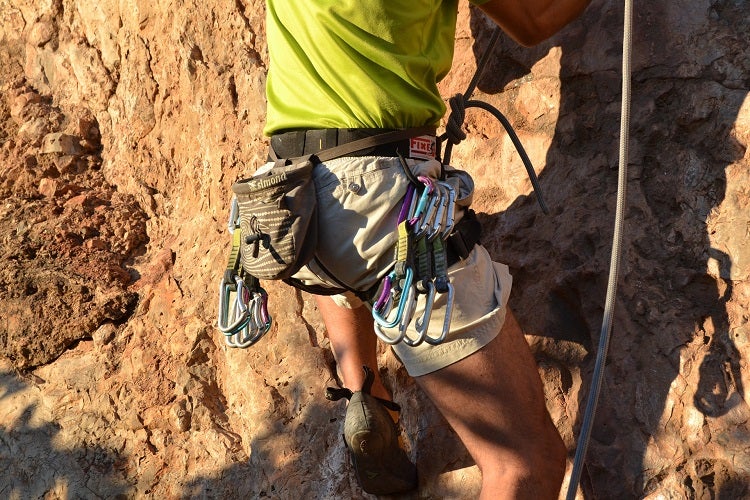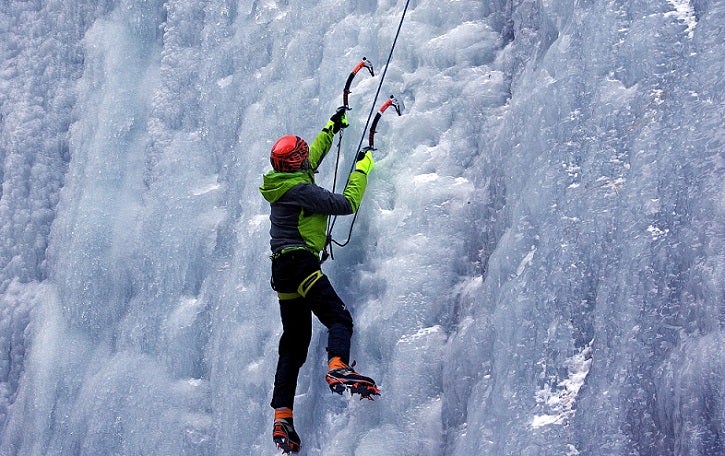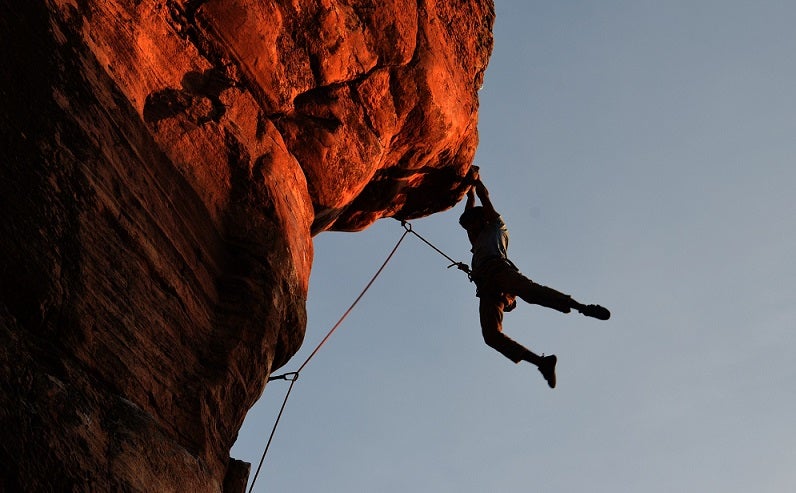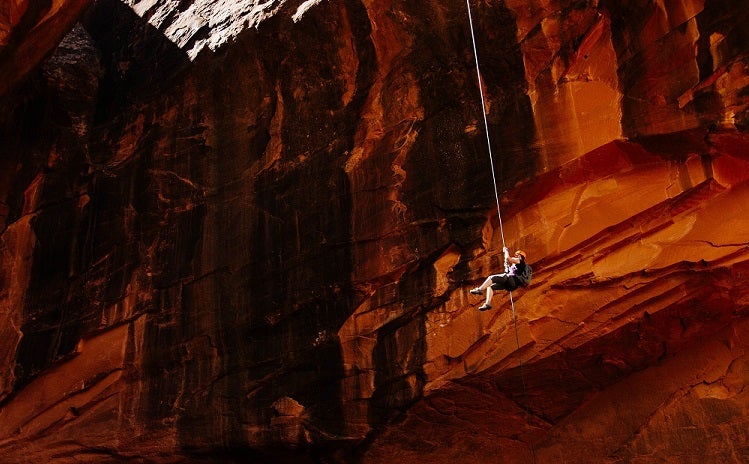
Our Editors independently research, test, and rate what we feel are the best products. We use affiliate links and may receive a small commission on purchases.
You literally trust a climbing harness with your life, so it is arguably among the most important pieces of equipment for a climber.
Any type of rope climbing requires a harness for both the climber and the belayer, the partner securing the climber’s ascent.
Our guide to the top rated climbing harnesses will make it easy for you to pick the right one for you and your climbing activity.
Best Climbing Harness
For more of my climbing gear recommendations, have a look through these popular Outside Pursuits guide links: Climbing Pants, Climbing Shoes, Climbing Rope, Climbing Helmets.
Quick Answer: The 5 Best Rated Climbing Harnesses For 2021
- Black Diamond Ozone Harness
- Edelrid Solaris Harness
- Arc’teryx AR-395a Harness
- Black Diamond Chaos Harness
- Black Diamond Aspect Harness
Nearly all of our climbing harnesses in our selections are suitable for more than one type of climbing, however we will give you our top picks for sport climbing for both men and women, alpine, trad and ice climbing so you’ll know exactly what to choose.
Best Climbing Harness For Men
#1 Black Diamond Ozone Harness
- Speed buckle adjustment for quickly getting in and out
- Fixed leg loops, contoured fit
- Four gear loops
- Breathable lining
- Abrasion-resistant shell
The Ozone harness is a sport climbing dream and therefore very popular with climbers. It’s optimized for high performance and lightweight as well as comfort and great fit.
Black Diamond achieves this by saving weight with fixed leg loops and using a triple-weave webbing on the interior for a flexible fit and excellent load sharing.
The material is breathable and comfortable, yet provides all the support you need to stay safe at any time.
The weight clocks in at slightly more than 10 ounces, making it one of the lightest harnesses available. It is ideal for sport and gym climbing and extended belaying.
You can even use it for comfortable trad climbing, if the four loops are enough for your gear, since there is no rear haul loop.
The harness is not suitable for ice climbing as it lacks ice clipper slots – if you need these, upgrade to the Black Diamond Zone. With minimal bulk and weight and waistbelt that is designed to be flexible, the Ozone moves with your body and never gets in the way.
If you are looking for the best beginner climber harness, the Black Diamond Momentum harness is your best bet. This comfortable harness is suited for all types of climbing and comes with easily adjustable leg loops.
It’s also available in a package with ATC belay device, a locking carabiner, chalk bag and chalk to get you started on your climbing career.
Best Climbing Harness For Women
#2 Edelrid Solaris Harness
- Four gear loops
- Rear haul loop
- Two ice clipper slots
- Adjustable leg loops
- Weighs only 14 ounces
The Edelrid Solaris is an all-around harness specifically for women. It excels in sport, trad and ice climbing and is optimized for comfort, lightweight and great fit, yet it can pack a lot of gear.
This harness is ergonomically shaped to specifically contour-fit the female body. It can be adjusted to fit all hip shapes and provides both security and comfort.
This is achieved by two separate waist straps to fine-tune the fit, yet a loop allows for quick and snug fastening.
The Edelrid Solaris comes with a wide waistbelt and leg loops for large contact zones.
The effect is excellent pressure dispersion and maximum load transmission, while ventilation is provided by ducts and breathable material. The front gear loops are shaped to push gear forward, so you’ll never grope for a quickdraw in tricky clips.
The only pain point: this harness is slightly bulkier to pack than more lightweight ones.
For the ladies, this women’s harness is equally great for taking falls in sport climbs, bringing loads of gear on trad routes, or hanging for extensive periods in big walls while you belay your partner up.
The Edelrid Solaris is durable, comfortable and versatile.
Best Alpine Climbing Harness
#3 Arc’teryx AR-395a Harness
- Self-locking buckles
- Adjustable leg loops for precision fit
- Four gear loops and rear haul loop
- Four ice clipper slots
- Weighs only 13.9 ounces
This is one extremely versatile harness with great features for all-around climbing.
The Arc’teryx AR-395a harness won awards and combines innovation, comfort and performance into a piece of equipment equally suited for alpine climbing, trad, sport and even ice.
It’s lightweight, compact, optimized for performance and mobility and keeps such a low profile you can focus exclusively on executing powerful moves in any environment.
Arc’teryx goes for ergonomic freedom and comfort with the AR-395a, yet the harness is durable, compact and supple enough to not hinder you in pushing your limits.
Material and design work together to disperse pressure and distribute loads evenly for the highest level of support.
If you’re an ambitious climber who spends lots of time in the harness, the AR-395a is a great friend, especially when you bring lots of gear up the wall. Keep note: other, more padded harnesses will be more comfortable, but at the cost of more bulk and weight.
Best Trad Climbing Harness
#4 Black Diamond Chaos Harness
- Speed adjust waistbelt buckle
- Bullhorn-shaped waistbelt for ideal weight distribution
- Adjustable, releasable rear risers
- Weighs only 12.5 ounces
Trad climbing requires more gear, which you need to haul up with your harness. The Black Diamond Chaos harness has a 12 kN-rated haul loop and four gear loops that offer a lot of rack space.
It is comfortable and durable and well designed for trad climbing and high-end multi-pitch routes.
The leg loops are fixed but are elastic and come with a soft, padded mesh interior for comfort, same as the waistbelt.
In highly exposed areas, the Black Diamond Chaos harness has welded patches to improve the durability even further.
The breathable mesh material on the inside of the belt and leg loops helps wick moisture away to keep you cool while you lead a route or hang for an extended belay.
While the Black Diamond Chaos is definitely an excellent choice for trad climbing and long routes, it’s equally suited for sport climbing and long sessions at the gym.
The only downside is that without ice clipper slots, you need to pick another harness for ice climbing.
Best Ice Climbing Harness
#5 Black Diamond Aspect Harness
- Four gear loops and a rear haul loop
- Durable abrasion patches
- Waistbelt constructed from two thin bands of webbing on the outside
- EVA foam insert for even distribution of weight without pressure points
Many climbing harnesses are versatile and can be used for ice climbing as well, but the Black Diamond Aspect is specifically designed for this type of climbing.
It performs well all year long and is suited for sport and trad climbing, but with four ice clipper slots for tools and screws, icy terrain is where the Aspect harness excels.
The speed adjust buckles on the belt and the leg loops can be used even with climbing gloves on and allow for any number of layers to be worn underneath throughout varying seasons, making this this a true four-season harness.
The Black Diamond Aspect harness weighs in at around 14.5 ounces, which is still decently lightweight for comfort.
Take note, the harness is slightly bulkier than lighter ones and is not as comfortable during multi-pitch routes as a more padded harness, but apart from ice climbing, you can use the Aspect harness for sport, trad and gym climbing as well.
How to Choose the Best Climbing Harness
- Which Model Harness is Right for You
- Usage
- Gear Loops
- Leg Loops
- Size & Fit
- Comfort
- Weight & Compactness
- Conclusion

Let the type of climbing you’ll do most in your harness guide you in your selection. Are you looking for a budget model for beginners, comfort during your gym and sport climbing sessions, a durable alpine climbing harness, a trad climbing hero with a heavy duty gear rack or a harness that can withstand harsh ice climbing conditions?
A climbing harness needs to fit well and ensure your safety, be comfortable when you use it extensively, and allow you to perform at your best by not hindering your movements and giving you quick and access to attached gear.
Which Model Climbing Harness is Right for You?
In all types of rope climbing, your harness needs to be there for you when you move, stand, sit, hang or fall. Safety is above all the most important issue, but your harness will influence your comfort and performance as well.
All your necessary gear needs to be within easy reach, while the material should not hinder your movements yet allow you to trust in its performance during a fall or stress situations.
A typical climbing harness consists of a belt that goes around your waist with a tie-in point for the rope, attached gear loops, a belay loop and leg loops suspended from the waistbelt with straps.
The waistbelt will distribute the weight and load and differs in size. Gear loops are placed on the sides and allow you to bring additional equipment with you.
The belay loop is made of strong webbing and connects the waist with the leg loops. It is used for securing your partner when climbing. The leg loops support you in sitting and hanging positions and aid in distributing the shock of a fall.
In the following, we’ll highlight important points to help you make the right selection for you.
How Will You Use It?
As you will have noted from our top picks above, the majority of climbing harnesses can be used for more than one type of climbing, from top rope routes in the gym and leading in sport climbing to traditional, alpine and ice climbing.
Define your focus and the activity you will be doing most, and think of a typical rock climbing day. Are you bringing lots of equipment up the wall, do you need to dress warmly, are you looking for comfort or little weight?
Your harness should be appropriate for the type of climbing you’re doing and can have the added benefit of all-around qualities. As a side note to family climbers, please keep in mind that a simple waistbelt harness is not enough for small children.
Due to their lower height, they need support for the upper body and back with a full body harness. Our pick here is the Edelrid Fraggle II climbing harness for kids, which features twist-free loops and two adjustable buckles to easily achieve a perfect fit.
Gear Loops
Specific forms of climbing require different equipment and varying amount of gear. Your harness needs to provide enough space and gear loops to allow you to carry quickdraws, cams, nuts, slings and more up the wall.
For the gym and sport climbers, four or even two standard loops are sufficient. Trad climbers will favor larger loops and a rear haul loop, while ice climbers need slots on the sides for ice clippers. Choose your harness so it can accommodate the kind of gear you’ll use.
A haul loop consists of webbing on the back of the waistbelt. A full strength loop is able to carry the weight of an additional rope or pack on long climbs and big wall routes, while a haul loop of plastic or elastic is only suitable for clipping a chalk bag or any other small piece of equipment.
Leg Loops
Climbing harnesses come with different types of leg loops. They serve to distribute weight between pelvis and legs by going around your upper thighs.
Leg loops can be fixed or adjustable. If you can manually fit them with their own buckles, it’s easier to wear the harness over different types of pants and clothing, but the buckles come with extra weight.
So does comfort: wider and more padded leg loops offer more support, while narrower, unpadded loops weigh less but will cut into your legs during sitting, falling or hanging. Just where your leg loops sit on your thighs can be adjusted with elastic rear straps.
On some harnesses, these can be released, which can make it easier to take off the harness.
Video: How to choose a climbing harness.
Size & Fit
Same as with your climbing shoes, picking the right size and fit is just as important as selecting the right type of harness for your style of climbing.
To begin, most manufacturers offer their harnesses in small, medium and large and sometimes have an extra small or large option.
Consult a specific sizing chart to see how a harness corresponds to your pant size. Yet that is not all: the physical shape and size of the waistbelt and leg loops contribute to how well a harness will fit you, and how it will feel during climbing.
The position of tie-in loop and belay loop play a role in leg loops riding up your thighs, while adjustable leg loops allow you to fine-tune the fit.
If you can, try different harnesses on to see how they fit your body. Determine how much adjustment you need. The waistbelt actually rests higher on your hips than your pants – upon the iliac crest.
It should be tight, but not restrictive or uncomfortable. If the waistband on the harness is pulled all the way and the waistbelt is still loose, the harness is too big for you.
Many climbing harnesses come with only one waist buckle, which reduces weight and allows for faster getting in and out of your gear, whereas two buckles on the waist allow for more fine-tuning.
When wearing the harness, the belay loop and tie-in loop should always be centered, not off to one side. Read the instructions on how to close buckles: most of them are pre-threaded and auto-lock for easy use.
Comfort
Especially as a beginner, comfort is high among your priorities. When you’re new to climbing, you’ll yet need to experience how it feels to hang and sit in your harness, to belay, and even to take a fall or catch a fall as a belayer.
If your harness is comfortable, all of these situations will be greatly improved. The comfort of your harness is determined by how padded and breathable the material is, as well as how big the waistbelt and leg loops are cut.
The load and pressure should be distributed evenly, with no individual pressure points. Softer material will adjust better to the movements of your body than a stiff frame. For women, we definitely recommend trying a women’s harness for greater comfort.
Weight & Compactness
A lighter harness can be more comfortable in the way that you’ll feel it less, but usually cutting down on weight means making some sort of compromise.
A lighter and smaller harness with a lower profile offers less bulk, can be compressed more for packing and weighs less, but you’ll have to accept some loss of comfort.
As a rule of thumb: more bulk and padding is great when you hang and fall a lot, lightweight and compact is great when every ounce of gear counts and you’ll be climbing for long periods of time.
In gym and sport climbing, you won’t mind a bulkier harness, whereas in trad and alpine climbing, you want to reduce weight.
Outside Pursuits Overview
In rope climbing, the harness is just as important as the rope in keeping you safe and catching your fall. All of the models above have no safety issues when used for the right kind of climbing and according to the instructions provided by the manufacturer.
Always read the manual for your specific harness to know how to tie in or set up a belay. For beginning sport and gym climbers, our picks for men and women or even the budget options listed are completely sufficient.
If you’re a more demanding climber, pick a harness that is suited for trad, alpine or ice climbing and appeals to your needs.
If your new to climbing be sure to read our “How to Start Rock Climbing” guide.
How We Researched
To come up with the top climbing harnesses we researched a variety of sources for reviews such as REI, Dicks Sporting Goods and Backcountry along with our own personal experience.
We also consulted online magazines for product research and reviews to get as much unbiased information as we could. To help weed out fake reviews we used Fakespot.com to make sure we only looked at genuine reviews.
With so much quality gear available, we had to narrow it down based on what we felt were the best options for the price. The author, Jakob Straub has extensive experience with rock climbing and bouldering. To help narrow down the selection they used their personal experience along with recommendations from instructors and retailers.
After extensive research, we came up with our list to help you choose the right one for you.
Sources
I hope this guide was helpful for finding a good climbing harness to fit your needs. If you want to comment or recommend a harness I didn’t include, please use my contact form to get in touch.
Be safe and happy climbing!


